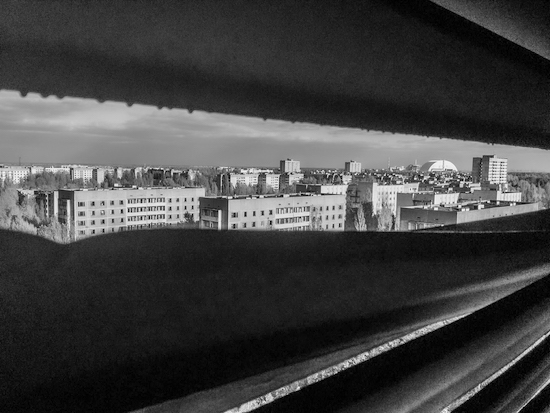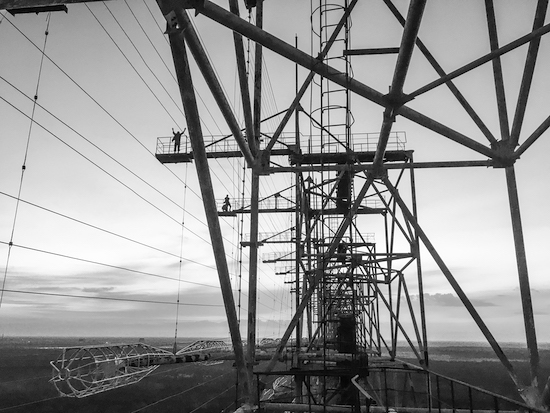All photos by Markiyan Kamysh
Forget the war for a moment. Since 1986 there has been an area of land between Kyiv and the Belarus border the size of Luxembourg which people are forbidden to enter. At its heart is the nuclear power plant at Chernobyl, which went into meltdown that year in what was probably the worst nuclear disaster in history. Nearby was the city of Pripyat. The city, and the whole area around the reactor, were evacuated. It is too dangerous, too radio-active. No-one has ever been allowed to return.
And yet people do go into the Exclusion Zone. Scavengers, drunks, idlers, illegal tourists. Some of them call themselves stalkers, after Andrei Tarkovsky’s still, strange, epic science fiction film of that name. It’s a somewhat self-mythologising term, for sure. Is it a cover for anything more than a callow kind of adrenaline-high thrill-seeking? On the evidence of Stalking the Atomic City, Markiyan Kamysh’s blunt bare ecstatic memoir, the answer has to be yes.
Stalking the Atomic City is published in translation here for the first time, but it covers the period 2012–14 and was first published in Ukraine in 2015. Kamysh is the son of a civil engineer who went into Chernobyl to help clear the debris in the immediate aftermath of the catastrophe. Kamysh himself began making regular journeys into the Zone in 2010. How much time did he spend there? Two hundred days, he calculates at one point; 1,146 trips, he reckons later. But time there is loose, unfettered. All co-ordinates are off. Pripyat, he says, is “huge and tiny at the same time”.
The Zone itself is frozen in time. The book opens on the utopian optimism of the Soviet Union, of which Ukraine was then a part, and the bright, technological future of nuclear energy. If the Zone is a place where time has stopped, it has stopped in a Soviet future that never was. But it is still subject to change and decay. The vent pipe of the nuclear reactor was dismantled, changing the skyline; Kamysh seems literally disoriented by its absence. Even within the Zone, then, there is an old Zone that’s gone. Murals are eaten from the ground up by the ferocious winters, a little more swallowed down each year. Plaster falls from the walls. Scrap metal disappears. The scavengers pick the ruins clean. And still they come – for elevator coils, for domestic wiring and cables, for whatever they can carry.

Meanwhile the Zone’s unknownness has become too known. It’s twice dead, Kamysh says. Dead once from the accident and dead again from official tours and hipster chic. “The aura of mysticism was scattered like ash in all directions,” he writes. But mysticism doesn’t seem quite what he’s after. More a kind of wildness, a life beyond the perimeter of laws and rules, the comforts of order.
But the Zone itself, its wildness, its abandonment, is a resource being used up, spent, eroded. “We’re obsessed with the moment that’s fading away forever,” he writes of his fellow stalkers. But also: “I really wish all this would pass into oblivion as soon as possible. So I could look at my old photos and remember those times with a sense of happiness.” Maybe the pristine toxic now of the Zone has a half-life that will outlive all those who experience it. “It’s only here that life won’t slip by me,” Kamysh says of it. He is pragmatic about the prospect of radiation poisoning. “Life often happens to us, and sometimes death does too,” he writes.
Still there seem to be rituals and codes. What to carry with you. How to get to the border. What to say to the police. Where to go each time: finding somewhere new is a ritual act too. Modern life is weight; in the Zone, “lightness … should always accompany you”. Fear falls away. Fear of the police, a constant presence, or of wolves out in the forests. The kingdom of Fenrir he calls the Zone at one point. (Who knew that a rotting wolf carcass smells exactly like tiramisu?) The snow is waist deep, chest deep, shoulder deep. You can drown in there.
Kamysh hates the clichés about ‘post-apocalyptic’ or ‘industrial’ landscapes. He’s absorbed in the “utter absurdity” of the here-and-now of the Zone: finding warmth in –20ºF, finding a can opener, finding condoms. Beer. Vodka. Tinned pork. Cigarettes. Why it’s important to carry a magnet, a pack of cards. Brand names litter the text like discarded wrappers: Pepsi, Snickers, Camel, Siemens, Festex, Zara. But then, what’s here-and-now about a place outside of time?

It’s tempting to call his trespasses acts of pilgrimage, and there is something votive about them, but they are a compulsion too, an addiction. The prose – or maybe the experiences it describes – has the quality of a fever dream. Kamysh is a stalker, but it’s the forbidden Zone that stalks him. The thought of it won’t leave him alone. He swears he will stay away. He always comes back. You might call these journeys entradas, after the word the Spanish used diving into the American interior after the fall of the Aztec and Inca empires. And the zone too is a kind of terra incognita. Yes, there are maps. But I don’t know if there are any maps for what Kamysh wants to find.
Russia’s invasion of Ukraine, and its brief seizure of the Chernobyl plant in March, is another thing stalking the text now. Does it sharpen the way you read it? I think so. Perhaps the Zone, the place of life-not-slipping past, is a third-time dead now. Perhaps its life-in-death is all the more needful.
Stalking the Atomic City is sometimes brashly self-regarding in its claim to outsiderness. But it has a rare quality of revelation about it and hums with a kind of exhaustedly beautiful intensity. It’s a short book. Take it as a whole, in one rush. “I embrace every spark of light with an insane sense of appreciation,” Kamysh writes of a winter twilight. What’s the Zone? It’s a place that’s dead to human life. What better place to feel alive.
Stalking the Atomic City by Markiyan Kamysh is published by Pushkin Press


